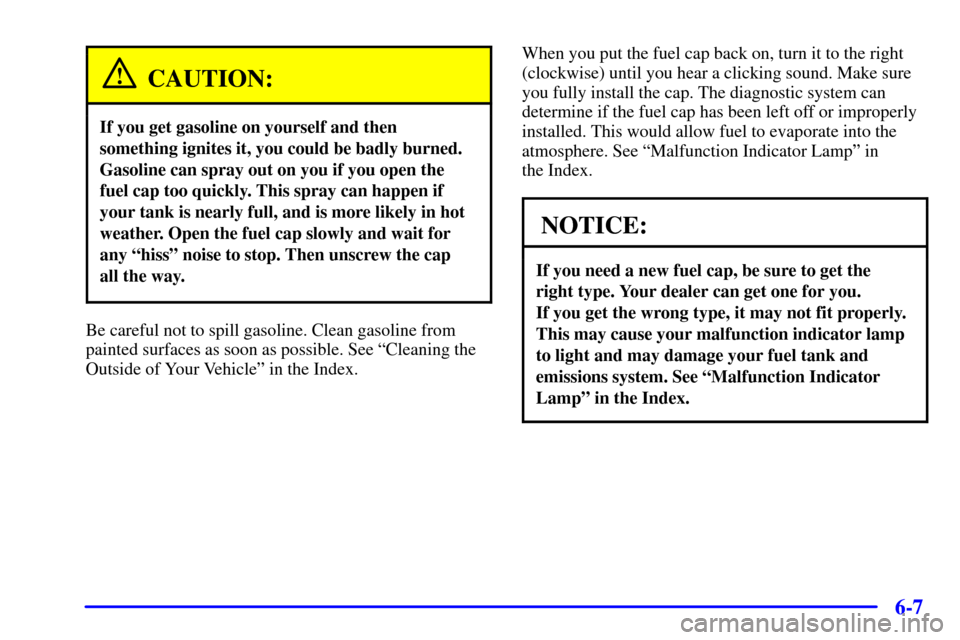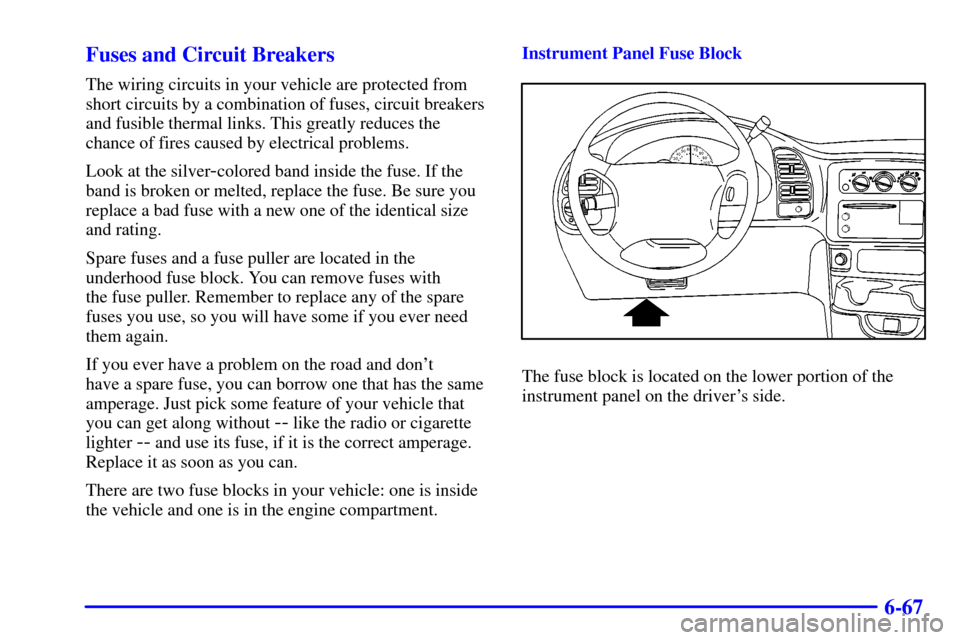Page 267 of 400

6-7
CAUTION:
If you get gasoline on yourself and then
something ignites it, you could be badly burned.
Gasoline can spray out on you if you open the
fuel cap too quickly. This spray can happen if
your tank is nearly full, and is more likely in hot
weather. Open the fuel cap slowly and wait for
any ªhissº noise to stop. Then unscrew the cap
all the way.
Be careful not to spill gasoline. Clean gasoline from
painted surfaces as soon as possible. See ªCleaning the
Outside of Your Vehicleº in the Index.When you put the fuel cap back on, turn it to the right
(clockwise) until you hear a clicking sound. Make sure
you fully install the cap. The diagnostic system can
determine if the fuel cap has been left off or improperly
installed. This would allow fuel to evaporate into the
atmosphere. See ªMalfunction Indicator Lampº in
the Index.
NOTICE:
If you need a new fuel cap, be sure to get the
right type. Your dealer can get one for you.
If you get the wrong type, it may not fit properly.
This may cause your malfunction indicator lamp
to light and may damage your fuel tank and
emissions system. See ªMalfunction Indicator
Lampº in the Index.
Page 284 of 400
6-24
Then, without shutting off the engine, follow these steps:
The transmission dipstick has a red handle and is located
near the center of the engine compartment behind the air
cleaner. See ªEngine Compartment Overviewº in the
Index for more information on location.1. Flip the handle up and then pull out the dipstick and
wipe it with a clean rag or paper towel.
2. Push it back in all the way, wait three seconds and
then pull it back out again.
3. Check both sides of the dipstick, and read the lower
level. The fluid level must be in the COLD area,
below the cross
-hatched area, for a cold check or in
the HOT area or cross
-hatched area for a hot check.
4. If the fluid level is in the acceptable range, push the
dipstick back in all the way; then flip the handle
down to lock the dipstick in place.
Page 285 of 400
6-25 How to Add Fluid
Refer to the Maintenance Schedule to determine what
kind of transmission fluid to use. See ªRecommended
Fluids and Lubricantsº in the Index.
Add fluid only after checking the transmission fluid while
it is hot. (A cold check is used only as a reference.)
If the fluid level is low, add only enough of the proper
fluid to bring the level up to the HOT area for a hot
check. It doesn't take much fluid, generally less than
one pint (0.5 L). Don't overfill.NOTICE:
We recommend you use only fluid labeled
DEXRON�-III, because fluid with that label is
made especially for your automatic transmission.
Damage caused by fluid other than DEXRON
�-III
is not covered by your new vehicle warranty.
�After adding fluid, recheck the fluid level as
described under ªHow to Check.º
�When the correct fluid level is obtained, push the
dipstick back in all the way; then flip the handle
down to lock the dipstick in place.
Page 303 of 400
6-43
5. Remove the remaining three screws: the first one
from the corner reflector pocket and the two
remaining from the composite assembly.
6. Remove the composite assembly.
7. Turn the halogen
bulb counterclockwise
to remove it from
the assembly.
8. Install the new bulb into the composite assembly by
turning it clockwise until it is completely tightened.
9. Reinstall the composite assembly by installing and
tightening all of the screws previously removed.
Page 304 of 400
6-44 Front Turn Signal Lamps
1. Remove the two screws at the inside edge of the
parking/turn signal lamp assembly.
2. Remove the lamp assembly.
3. Squeeze the tab on the
side of the lamp socket
while turning the socket
counterclockwise.4. Pull the socket out of the lamp assembly.
5. Pull the bulb from the socket.
6. Gently push the new bulb into the socket.
7. Put the socket back into the lamp assembly
and turn it clockwise until it locks.
8. Put the parking/turn signal lamp assembly back
into the vehicle and tighten the screws.
Page 306 of 400
6-46
4. Press the tab and
turn the socket
counterclockwise to
remove the socket
from the bezel.
If the socket does not
have a tab, turn the
socket counterclockwise
to remove the socket
from the bezel.
5. Remove the old bulb from the socket and replace it
with a new one.
6. Reverse Steps 1 through 4 to reinstall the taillamp.Windshield Wiper Blade Replacement
Windshield wiper blades should be inspected at least
twice a year for wear and cracking. See ªWiper Blade
Checkº in the Index for more information.
To replace your
windshield wiper blade
inserts, do the following:
1. Lift the wiper arm away from the windshield.
2. Pinch the two tabs on the wiper arm and slide
the insert out of the blade.
3. Slide the new one in place.
Make sure the tabs are locked into position.
See ªNormal Maintenance Replacement Partsº in
the Index for the proper type of replacement blade.
Page 327 of 400

6-67 Fuses and Circuit Breakers
The wiring circuits in your vehicle are protected from
short circuits by a combination of fuses, circuit breakers
and fusible thermal links. This greatly reduces the
chance of fires caused by electrical problems.
Look at the silver
-colored band inside the fuse. If the
band is broken or melted, replace the fuse. Be sure you
replace a bad fuse with a new one of the identical size
and rating.
Spare fuses and a fuse puller are located in the
underhood fuse block. You can remove fuses with
the fuse puller. Remember to replace any of the spare
fuses you use, so you will have some if you ever need
them again.
If you ever have a problem on the road and don't
have a spare fuse, you can borrow one that has the same
amperage. Just pick some feature of your vehicle that
you can get along without
-- like the radio or cigarette
lighter
-- and use its fuse, if it is the correct amperage.
Replace it as soon as you can.
There are two fuse blocks in your vehicle: one is inside
the vehicle and one is in the engine compartment.Instrument Panel Fuse Block
The fuse block is located on the lower portion of the
instrument panel on the driver's side.
Page 328 of 400
6-68
Fuse/Circuit
BreakerUsage
1 Stop/Turn/Hazard Lamps,
Center High Mounted Stop
Lamp, Anti
-Lock Brakes
2 Radio Accy, RR Seat
Audio ControlsFuse/Circuit
BreakerUsage
3 Courtesy Lamps, Glove Box Lamp,
Dome Reading Lamps, Vanity
Mirror Lamps, Courtesy Lamps
4 Daytime Running Lamps Relay,
Instrument Panel Cluster
5 Rear Defogger
6 Cruise Module, TBC Module,
Instrument Panel Cluster,
Cruise Control Switch,
Electrochromic Mirror
7 Power Outlets, DLC,
Subwoofer Amplifier
8 Crank Circuit Fuse, Park/Neutral
Switch, Starter Enable Relay
9 License Plate Lamp, Taillamps,
Parking Lamps, Ashtray Lamp,
Panel Lights, Trailer Taillamps,
Front and Rear Sidemarker
Lamps, Door Switch Illumination,
Headlamp Switch Illumination,
Rear Seat Audio Illumination,
TBC Module